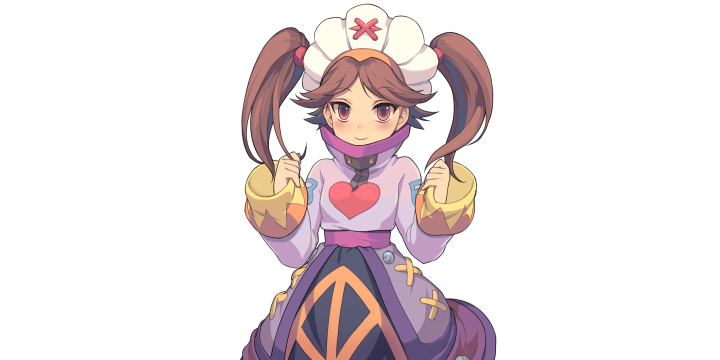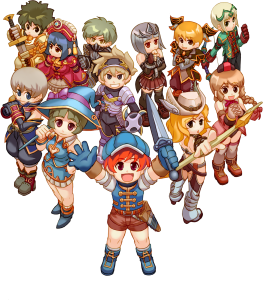Basic HnR Elementor Guide
Table of Contents
Introduction
Do you want to become a powerful mage, a master of the elements—a Hit and Run Elementor? If so, then you should watch this guide. But before we start, a few important notes: This guide is primarily aimed at free-to-play players. This means no consumables, no highly upgraded equipment, and we won’t assume you have access to a high-level Ringmaster for constant buffs. Also, you should already be at least a level 60 Magician, as this guide is intended for players ready to transition into the Elementor class. If you need help with the Magician class, we have a 1v1 Mage and a HnR Mage guide to assist you.
Stat Points "H"
Let’s start with the basics—stat points. This is very straightforward. You just need to go Full INT
Skill Points "K"
Next up are the skills. Both Magicians and Elementors have a wide range of skills, which can be seen as either an advantage or a disadvantage. The downside is that you’ll need a lot of skill points to maximize the most important ones. For Magicians, skill choice is relatively flexible because it doesn’t make a huge difference early on. However, you should definitely utilize different skills to take advantage of elemental weaknesses in enemies. For instance, relying solely on Mental Strike, like many players did back in the day, can work, but it’s inefficient compared to using the correct elemental skills. Using the right element can save you a hit or two, so it’s definitely worth doing.
One crucial tip: Do not use your reskill, which you receive at level 15 during the Magician job change, until you reach level 65 as an Elementor. It’s vital to conserve as many skill points as possible for when you need them later. Avoid maxing out unnecessary skills that you won’t use as an Elementor, such as Hot Air. The only skill from the Magician class that you should max out is Blinkpool; everything else should be kept at the absolute minimum required to unlock further skills. For example, at the Magican Skill Tree, keep the first row of skills at their minimum levels, which is usually around 5 at the first Skill Tree column, 7 at the second, and third Skill Tree column, to meet the prerequisites for Elementor skills.
Skill Allocation for Elementors
Once you transition to an Elementor, it becomes extremely important to carefully manage your skill points. The first row of skills as an Elementor should be kept to the minimum as well, as they are mostly single-target (1vs1) skills, which are not essential for an Elementor. The strength of the Elementor class lies in its vast array of AoE (Area of Effect) skills, so you can safely ignore maxing out the initial single-target skills.
Starting at level 65, you’ll gain access to your first AoE skills. By this point, you might have already spent a significant amount of skill points just to unlock these skills, so you need to choose your main skills wisely. Our recommendation is to max out Earthquake and Poison Cloud at level 65. These are your core Hit-and-Run (HnR) skills, and together with Blinkpool, they form the foundation of your playstyle strategy.
Earthquake will serve as your pulling skill, especially before you reach level 70 when your skill options are limited. Poison Cloud is your main DPS (damage per second) skill, dealing consistent damage to all enemies in the area. On the other hand, skills like Electric Shock are less useful for an HnR playstyle, as it is a non-targeted, close-range skill that doesn’t fit well with the hit-and-run tactics.
Another key point is the use of Windfield. Unlike in FlyFF PC, Windfield in FlyFF Universe should not be used for pulling mobs. It is better suited as a finisher skill. Windfield is useful for slowing down enemies when you don’t have enough damage to finish them off before they start moving again. It should only be used after gathering the mobs and not for the initial pull, as slowing them too early can make it harder to group them together efficiently.
Skill Mastery and Final Tips
Finally, we recommend that you focus on maxing out the skills you actually use. For example, after maxing Earthquake and Poison Cloud, invest in their respective Masteries to further enhance their effectiveness. You should max out the Earthquake and Poison Cloud Masteries first, as these correspond to your primary attack skills. It’s also wise to put at least one point into each of the level 70 skills, especially the ones you need for pulling, but max out the ones you use most frequently.
In summary, prioritize the skills that are essential for your playstyle, and avoid wasting skill points on those that aren’t necessary for an Elementor’s playstyle. With careful management of your skill points and a strategic approach to gameplay, you’ll be well on your way to mastering the Elementor class.
Cloak
For the Elementor cloak, the best choice is a +8 INT Cloak of Wisdom. There’s really no alternative here, as our primary focus is avoiding taking damage rather than tanking it. Even in ultra-high-level scenarios, where you might consider a STA cloak (Cloak of Endurance) for dungeons, the difference made by an additional 8 STA is negligible. Therefore, always opt for the +8 INT cloak.
Pet
The choice of pet is straightforward as well. We aim for maximum damage, not HP or tanking capability. Hence, the best pet for an Elementor is the Fox, which provides an INT boost.
Jewelry
When it comes to jewelry, the goal is simple: maximize INT, additional damage, and MP efficiency. At level 60, a typical setup might include two Intiret +1 rings, two Mighteer Earrings +1 earrings, and possibly a Mental Necklace +7. If your necklace is only +3 at the start, that’s fine, but a slightly better one would be beneficial, especially if you can’t rely on Refreshers constantly. Alternatively, you might use a Socecle +1 Necklace from Meteonyker, but it’s not crucial.
As always, the higher your jewelry’s level, the better. When you can afford to upgrade, consider improving your Intiret rings to something like Intelli Ring +14. Personally, we recommend focusing on INT for rings because additional damage from earrings doesn’t scale as well for Elementors as it does for other classes, like Blades. INT provides a more significant damage boost in proportion. If you need to choose between upgrading an earring or a ring, always prioritize the ring because INT yields more damage relative to additional damage bonuses.
Weapon Upgrade
Weapon upgrades are a unique and somewhat tricky aspect for Elementors. Unlike other classes, such as Blades, upgrading a weapon from +8 to +10 doesn’t provide a massive damage boost relative to the cost. Yes, you do get more damage, but it’s not as significant compared to other classes. Therefore, our opinion, a +8 weapon is sufficient to start with. You can always upgrade further if you have the Penya, but the price difference between +8 and +10 is usually substantial, and it’s wiser to be content with a lower upgrade initially. Scroll of Intelligence for 2~4 INT each equipment part.)
Regarding socket cards, we would suggest either INT (Water Card) or skill damage (Volt Card). Water cards are typically more expensive and offer a slight increase in damage, while Water cards are generally cheaper and provide a minor damage boost alongside reduced MP consumption. This reduction is particularly beneficial for free-to-play players who may not have constant access to Refreshers. High Elementors, for instance, is fully independent of Refreshers due to having like ten Volt A cards in our weapon, resulting in a 30% reduction in MP consumption. Additionally, a game necklace could later further reduces MP usage by 14%, totaling a 44% reduction. This makes my Elementor self-sufficient, with almost no need for Refreshers. Though the cards are expensive and high-level, Water cards offer a similar benefit with reduced MP consumption, making them a viable alternative.
Skill Damage and Elemental Focus
Skill damage and elemental focus go hand in hand for Elementors, as the class name suggests. The elemental aspect plays a role, but only at +1. For example, if you want to boost the damage of your water skills, you should apply Water +1 to your weapon. However, only upgrade to +1 because upgrades beyond +1 (e.g., +2 to +10) provide the same damage output. Therefore, upgrading beyond +1 for damage purposes is pointless—unless you care about aesthetics.
The synergy between skill damage and the elemental upgrade on your weapon is crucial. You want to align your skill awakening with the element of the skill you use most frequently. For instance, if you primarily use Poison Cloud, which is a water-based skill, you should have Water +1 on your weapon. This principle applies across the board: if you wish to enhance your Earthquake skill, you’d need Earth +1 on your weapon. However, boosting one element can decrease the effectiveness of another still. For instance, using Earth +1 for Earthquake would diminish the damage of Poison Cloud. This dynamic is essential to understand for optimizing your damage output.
Recommended Skills and Dungeon Strategy
For leveling, we highly recommend focusing on Poison Cloud, as it’s the strongest skill with the highest damage output and overall utility. Consequently, Water +1 on your weapon is the best choice for leveling.
For dungeon runs, however, Poison Cloud is less effective, unless you’re in a fire-based dungeon like Guardian Sanctuary. Even then, it’s not ideal due to its relatively long cooldown. In such cases, Electric Shock would be a smarter choice, so you’d want to have Lightning +1 on your weapon.
Important Assist/Ringmaster Buffs for Elementor
When it comes to buffs, always start by buffing your Ringmaster with Mantal Sign twice before moving on to your main character (to get the buff boost, which you get every 25 INT). Focus on maxing Mental Sign, Haste, and Quick Step. These are the three essential skills for a Hit-and-Run Elementor. Quick Step increases your movement speed, Haste boosts your attack speed and casting time, and Mental Sign increases your main damage attribute, INT. This setup is particularly effective for Mages, as both the Ringmaster and your main character benefit from Mental Sign, providing a significant boost to your overall performance.
After these core buffs, the next priority is HP-related buffs. Even as a Hit-and-Run player, it’s crucial not to die in one hit if you make a mistake. Therefore, focus on buffs like Heap Up and Patience, which increase your HP, and Cats Reflex, which enhances your block rate. For Elementors, who naturally have low block rates and defense, these buffs won’t make a massive difference, but they still provide valuable survivability.
Set Upgrades and Sockets
Regarding set upgrades, until you reach level 105, we recommend upgrading your gear to +5 with two or three sockets (Lighting Card 4%, Attack+4%). There’s no need to spend excessive amounts of money that you likely don’t have. Aim for sockets that increase attack power. Achieving a +5 or +6 set with a low chance of failure can be done relatively easily, even if you have to do it yourself. However, it’s generally more cost-effective to buy pre-upgraded equipment rather than upgrading it yourself.
From level 105 onward, aim for a set with at least four sockets and a minimum of 16% Attack. While upgrading to +8 doesn’t drastically improve an Elementor’s performance, you’ll find it hard to get a set with 16% or more Attack that isn’t already at +8. Therefore, aim for a +8 set with 16% Attack starting from level 105. Upgrading to +10 and achieving 28% Attack is nice to have, but it’s by no means essential.
Sets
When it comes to choosing sets for your Elementor, the early game is quite flexible. The main attribute you want to focus on is casting speed, and conveniently, all sets up to level 105 provide 15% casting speed. This means it doesn’t really matter which specific set you choose early on. Personally, we prefer the Teba/Misty set because it can be equipped at level 45. People usually don’t switch to the Ahes/Anoos ser at level 60 since it’s very similar to Teba/Misty but offers slightly less damage. The Ahes/Anoos set does provide reduced MP consumption and HP recovery, but these benefits aren’t essential for an Elementor focused on dealing damage.
At level 75, many players debate whether to upgrade to the Myuran/Myurian set. While some say it’s not necessary, we believe it does make a difference. The Myuran/Myurian set provides a bit more survivability (because of its basic defense), which can be crucial sometimes for a Hit-and-Run Elementor to survive when you get unwanted to much hits at ones. It also continues to reduce MP consumption, which is important for players who don’t use consumables constantly. Plus, the 15% casting speed boost is still there, making it a solid choice.
At level 105, switching to the Shabel/Shurian set is almost a no-brainer. It offers a bit more INT, 5% more casting speed, and an additional 10% movement speed. The speed boost is particularly noticeable in areas like the Darkon 3 desert, where mobility is key
Level 120 and Beyond: Choosing the Right Set
The decision to switch to the 120 set can be a bit controversial. While the Nanemvis/Namavis set provides significantly more damage for each skill (PvE +15%), you do lose 5% casting speed and 10% movement speed. The loss of speed can be particularly painful, as both of these stats are crucial for a Hit-and-Run Elementor. However, the increased damage, +25% HP, +10% block rate, and +15% PvE damage reduction can you feel almost invincible, especially when fighting Yetis in Azria. Even skills of the wrong element started dealing significant damage, making the 120 set a powerful, though not essential, option.
That said, you could skip the 120 set and continue leveling up to 135 with the Shabel/Shurian set. It’s not a mistake to switch to the 120 set, but it’s more tailored for tanking Elementors, not necessarily for Hit-and-Run playstyles.
At level 135, we recommend switching back to the Quinox/Quition set. This set offers 30% casting speed, which is a huge boost compared to the 5% you lost with the 120 set. Additionally, it provides 10% attack and +20 INT, making it the perfect all-in-one package for Elementors. You get casting speed, movement speed, attack, and INT—all the stats you need with no unnecessary ones.
The 150 Sets: A Complex Decision
When you reach level 150, things get a bit tricky. The new 150 sets are incredibly expensive, especially the 1vs1 Drakorin/Drakoria set or those from high-level dungeon “The Wilds”. Achieving 200% casting speed without consumables requires a perfect setup: maxed out buffs,ultimate jewelry, a staff with excellent casting speed rolls, and the 150 1v1 set. This setup is expensive and not achievable for most players. If you have all of these items, you can reach the max casting speed, which is capped at 200% in the game.
However, there’s an alternative: the 150 PvE Lippin/Lypine set, which is essentially a copy of the 120 set but with better stats. This set gives you 15% casting speed, which is 20% less than the 1v1 set. This drops your casting speed. But if you use a casting speed potion and cotton candy, you can reach exactly 200% casting speed, the game’s maximum. At 200% casting speed, you’ll deal much more damage with the PvE set because it offers 20% PvE damage and a +5% bonus to all elements Mastery, compared to the 1v1 set’s 30 INT and 15% Attack.
While the PvE set is more complicated and reliant on consumables to reach 200% casting speed, it offers significantly more damage. For most players who don’t want to rely on constant consumables, the 1vs1 set remains the better long-term option, though it is extremely costly at the moment.
Elementor Weapons
When it comes to weapons for your Elementor, you have a wide range of options early on. The Stick of Vel Parpone offers 10% casting speed and a 5% bonus to Wind mastery. Unfortunately, Wind mastery doesn’t benefit all elements, so it’s mainly the casting speed that makes this staff valuable. If you have it, it’s a nice option. Another early choice is the Sege Staff, which is a level 57 weapon that drops from regular monsters. It also provides 10% casting speed, making it a very affordable and practical option.
Why mention these two weapons? Because the Guardian Staff, a level 60 weapon, only provides the same 10% casting speed and an additional 20% MP, which isn’t particularly useful. Reduced MP consumption would be better, but it’s not crucial. The key issue with these weapons is that, ideally, you want to awaken a skill (with Scroll of Weapon Bonus) that enhances your AoE damage. However, all the main AoE skills for Elementors unlock at level 65, and Stick of Vel Parpone and Sege Staff weapons are below that level. Skills like Poison Cloud or Earthquake can’t be awakened on these weapons because their level is too low (not the required level 65 of the skill).
Early Game Weapon Choices
The casting speed boost is the most significant feature of these early weapons. Attack power doesn’t make a huge difference for Magicians or Elementors, so we would still recommend the Guardian Staff since it offers the most damage. However, it’s not strictly necessary. The unfortunate part is that your first staff with skill damage awakening will either come from a random drop or possibly from crafting, but you’re unlikely to find a weapon with a useful skill awakening until later.
Up until level 75, you’ll likely have to make do without a weapon that boosts specific skill damage. Even though this is frustrating, the casting speed from these weapons remains crucial. Once you hit level 70 or 75, you can consider the Staff of Iblis, which theoretically offers the most damage per hit due to its 10 INT and 5% skill damage boost. However, it lacks casting speed, making it less viable because casting speed is critical for every aspect of playstyle, from attack skills to mobility skills like Blinkpool.
Mid to Late Game Weapons
As you progress, the Historic Staff (Level75) becomes your go-to weapon. It provides 15% casting speed, 10 INT, and potentially a good awakening. Look for awakenings that boost critical skills like Poison Cloud or Earthquake—these are ideal. Avoid awakenings for skills you rarely use, like Windfield if you don’t rely on it.
Moving forward, Legendary Golden Staff (Level 105), Angel Staff (Level 90) and Bloody Staff (Level120)—all are a solid upgrade as you level up.
For players continuing with the Hit-and-Run strategy beyond level 150, the Lusaka’s Crystal Staff is not ideal. This staff has a chance to slow enemies with every skill cast, effectively turning each skill into a potential Windfield. This is problematic because you don’t want your pulled mobs to be slowed randomly. Although the slow chance is low, it’s still annoying when it happens.
Endgame Weapon Recommendation
Instead, opt for the Conch Stave (Staff of Hernes). (All Elements Mastery +18~23%, Casting Time +26~30%, INT +22~28.) While it may be slightly weaker depending on your specific rolls, it has a much better effect: it grants a chance to cast an additional AoE skill called Waterbomb +4~9%. This skill deals extra AoE damage based on your primary attributes, essentially scaling with your level. This makes it the superior option for Hit-and-Run Elementors because it increases your damage output without the unwanted side effect of slowing enemies.
Though the Conch Stave might be more expensive and harder to find, it is the optimal choice for maximizing damage without compromising your strategy.
HnR Elementor Playstyle
We want emphasize that everyone can play their Elementor differently. There’s definitely room for personal preference. It’s silly to say you must play a certain way or you’re doing it wrong. Everyone should play in the way that suits them best. We are just showing you how we would play; if you prefer a different style, that’s perfectly fine.
Skill Usage Overview
We start by pulling with Earthquake, which you could set to F1. For you, F1 should always the standard skill that you use most often.We also try to keep Poison Cloud on cooldown. This means using it wisely, not wasting it on a single monster, but deploying it whenever you have a group of monsters following you. Keeping Poison Cloud on cooldown ensures that a bunch of enemies are continuously weakened. If you don’t do this, they’ll eventually run away, and the hit-and-run strategy becomes ineffective. The goal here is to maximize damage output, so always use Poison Cloud strategically and as often as possible.
Then, F1 through F3 are Lightning Storm, Sandstorm, and Meteo Shower. You use these skills either to finish off enemies or to pull, especially since one of them is usually the most effective against certain elements. For example, Meteo Shower does massive damage against wind monsters because fire is highly effective against wind, Sandstorm against Lightning monsters. Similarly, Lightning Storm would be extremely effective against water monsters.
Blizzard is another skill, but with a different function. Blizzard is highly effective against fire monsters, but it has a long cooldown, so you could use it to pull because it has a greater range of eight compared to Earthquake, which has a shorter range of six (shown by hovering over the skill). If you see a group of monsters that aren’t tightly packed, Earthquake might only pull three of the five, whereas skills like Blizzard would hit all five and pull them together. This makes a significant difference in your ability to control the battlefield.
Combo Techniques
Two important skills are Blizzard and Burningfield, which you should always try to use together. Ideally, use Burningfield first and then Blizzard, or sometimes you need to use Blizzard to save yourself and follow it up with Burningfield. In a hit-and-run scenario, always try to use Burningfield just before or immediately after Blizzard.
Blizzard has an 80% chance to stun, which is quite high. This means that most of your enemies will be stunned and unable to move, allowing them to take continuous damage from Burningfield. Unlike Poison Cloud, which is a debuff that sticks to the enemy, Burningfield is a static damage-over-time AoE skill. This means that only monsters standing within the Burningfield take damage. Stunning them with Blizzard ensures they stay within the field, maximizing your damage output.
Finishing Moves and Additional Skills
Windfield is in your action slot because it’s one of the few spammable skills without a cooldown. You use it as a finishing move when necessary. Electric Shock is another skill, but we’ve already explained that it’s close-range and not suitable for hit-and-run tactics.
In practice, you would pull with Earthquake, and if you see four monsters, for example, you might not pull them all with Earthquake alone. Using Blizzard or another long-range skill ensures you pull all monsters in the area. Don’t forget to use Blinkpool for movement—it’s essential for Magicians and Elementors.
Once you’ve pulled your monsters, use Poison Cloud again as soon as it’s available. Then, use the Burningfield and Blizzard combo. You’ll notice that the monsters are stunned and taking continuous damage within Burningfield. However, since Burningfield has a shorter cooldown than Blizzard, you can use Burningfield again without waiting for Blizzard, especially if there are still monsters in the area.
Handling Higher-Level Monsters
As you progress, you might encounter monsters with significantly higher HP starting in Azria. If your damage output doesn’t keep pace with their HP, and your equipment isn’t upgraded accordingly, you might struggle to kill them quickly. In this case, you can pull the monsters and spam Windfield to slow all monsters, giving you more time to use all your skills effectively. Just make sure the fastest monster doesn’t reach you first. Then, use Earthquake, Windfield, and your other AoE skills to deal as much damage as possible before the monsters reach or escape.
This is the classic AoE tactic: slow everything and then kill it. It doesn’t work as well in FlyFF Universe due to the time limits on instances, so only use this method if you’re not making enough damage to ignore the time limit. Otherwise, stick with faster methods.
Managing Difficult Situations
HNR Timer
Finally, we want to quickly show you the hit-and-run timers when monsters will start to flee. However, this will only be a rough overview because you’ll never really calculate the exact seconds while leveling up.
Focus Timer Overview
The focus timer is now based on the number of monsters targeting the same player:
- 3 minutes for under 4 monsters
- 80 seconds for 5 to 7 monsters
- 50 seconds for 8 to 13 monsters
- 28 seconds for 14 or more monsters
As an Elementor engaging in hit-and-run tactics, you should always aim to have more than 14 monsters chasing you. This means that, generally, you can expect a focus timer of 28 seconds.
Intuitive Gameplay
That said, you won’t start counting monsters or timing seconds meticulously; it’s more about developing an intuitive feel for the game. Over time, you’ll have a sense of when to use certain skills based on your experiences.
It’s essential for an Elementor to practice, practice, and practice some more. You need to develop a feel for how many monsters you can pull and how long you can keep them engaged before you need to start dealing damage. For example, can you really rely on Poison Cloud to take down your monsters
Building Experience
As you play, you’ll naturally develop this instinct, which comes with time. While it’s possible to learn the mechanics, it’s important to practice regularly. If you don’t put in the effort, this sense of timing and skill usage won’t develop on its own. It takes time and experience to master these aspects of gameplay
Source: The Guide was originally explained by Spielestyler in his YouTube video in German.










